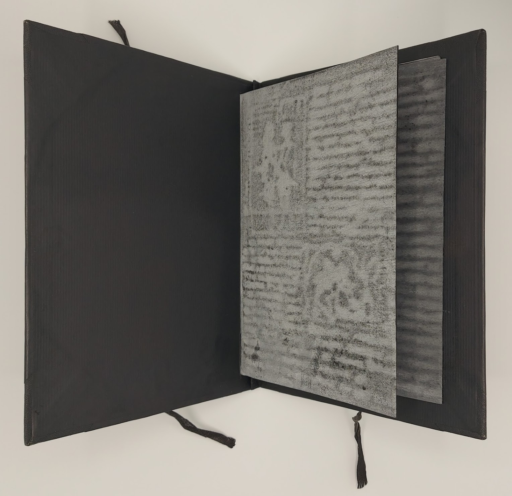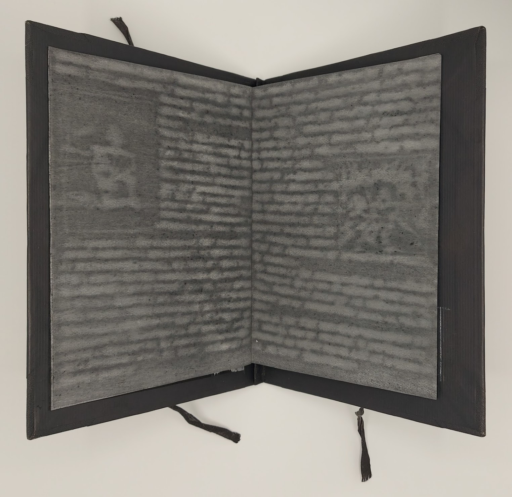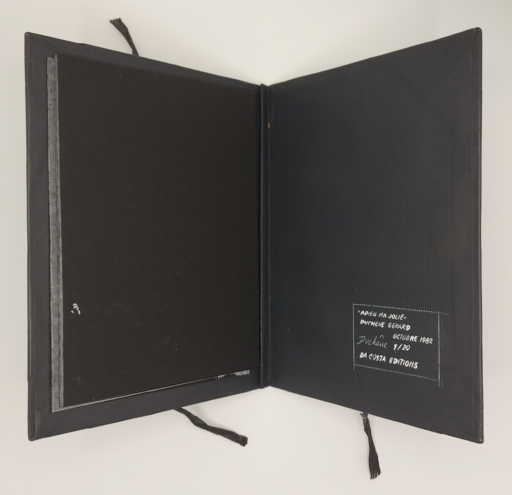Gérard DUCHÊNE
Adieu ma jolie
Amsterdam: Da Costa [1982] p. 81, Notice 1982-01 Leporello horizontale: ill.; 30 x 215 cm. Porte-folio: ill. 33 x 25,5 cm. Bibliogr.: Gérard Duchêne: les livres, Domart-en-Ponthieu : Maison du livre d’art contemporain, 1992 [Notice 1992-05]. Réalisé en 20 exemplaires. Empreinte du Journal d’IL sur papier Canson noir. Ref.1
Arts, Artist Book, Avant-Garde
Info
Ex. 1/20 de cette édition autobiographique (Ref.3) dans un tirage très limité à seulement 20 exemplaires réalisés à la main.
Ex. 1/20 of this autobiographical edition (Ref.3) in a very limited edition of only 20 handmade copies.
Autres exemplaires localisés / other copies located:
• Ex. 3/20 Collection Anne et Florence Duchêne, exemplaire personnel de Gérard Duchêne et 1 version en empreinte blanche, sur 1 seule planche 29 x 190 cm Ref.1
• Ex. 7/20 School of the Art Institute of Chicago Library & Special Collections, Joan Flasch Artists' Book Collection: Accessionnumber 4100.07. Colophon title.; "Accordion-style into boards covered in paper with cloth spine and corners and ribbon closures.; Library has copy n°. 7/20, signed by the artist.; Donated by Tony Zwicker. Ref.2
• Ex. 16/20 Lille Médiathèque Jean-Lévy Réserve Fonds précieux Cote : R20-4-207 Ref.1
Extrait d’entretien :
Il: Tu écris tes matrices de façon autobiographique. Pourquoi ? A une certaine époque il s’agissait de récupération de textes imprimés. Pourquoi ce glissement ?
Je: Il fallait bien que cette question de l’autobiographie arrive. J’ai déjà eu à parler de mon écriture des matrices, j’ai parlé de mon rapport à l’intimité et à l’écriture intime à propos de la question sur l’identité.
C’est vrai du journal d’Il, comme d’un certain nombre de mes livres (je pense notamment à “Adieu ma jolie” écrit à la suite de mon divorce). Comme l’écriture, ma vie, ma biographie me servent de matière première, et j’adopte face à cette matière, une attitude de distance qui conduit à une forme d’autodérision.
Tout cela s’appelle souffrance. Cela s’appelle quelquefois désespoir. Ma seule autobiographie, c’est celle qui s’écrit dans mon travail de peintre.
J’ajoute que si, du point de vue textuel, mon travail a glissé, pour ces raisons, du texte imprimé à mon journal écrit, je conserve largement le rapport à l’imprimé : par les OCNI, comme par tout mon travail d’oblitération des affiches publicitaires. Ref.3
Interview excerpt:
He: You write your matrices autobiographically. For what? At one time it was about the recovery of printed texts. Why this shift?
I: This question of autobiography had to come up. I have already had to talk about my writing of matrices, I have spoken about my relationship to intimacy and to intimate writing regarding the question of identity.
This is true of Il's diary, as of a certain number of my books (I am thinking in particular of “Adieu ma belle” written following my divorce). Like writing, my life, my biography serve as raw material for me, and I adopt an attitude of distance towards this material which leads to a form of self-deprecation.
All this is called suffering. This is sometimes called despair. My only autobiography is the one that is written in my work as a painter.
I add that if, from a textual point of view, my work has slipped, for these reasons, from the printed text to my written journal, I largely retain the relationship with the printed word: through the OCNI, as through all my work of obliteration of advertising posters. Ref.3
- Gerard DUCHÊNE, Lille, 1944 – 2014 Peintre et écrivain, son œuvre se caractérise par l’ambiguïté de cette double activité L’artiste publie, en 1964, ses premiers écrits poétiques dont le nom rassemble dans son articulation même (texte, texture, destruction), ce mode d’expression, qui marque le passage d’une écriture « écrite » à une peinture« lettrée », vise à libérer le langage de ses codes pour les rendre à leur matérialité, réagissant contre la pression exercée par les monopoles d’éditions Gérard Duchêne participe aux activités du groupe Textruction de 1971 à 1974 dont le nom vise à libérer le langage de ses codes pour insister sur sa matérialité Après la dissolution de Textruction en 1974, Gérard Duchêne poursuit sa pratique de l’illisible en peinture avec son œuvre majeure, Journal d’il, qu’il débute en 1977. Son intérêt pour le livre ne s’est jamais démenti, qu’il s’agisse d'inclure dans son propre travail ou d’y être associé à travers les nombreux ouvrages qu’il a accompagnés comme peintre Ref.4
- Gerard DUCHÊNE, Lille, 1944 – 2014 Painter and writer, his work is characterized by the ambiguity of this double activity. The artist published, in 1964, his first poetic writings whose name brings together in its very articulation (text, texture, destruction ), this mode of expression, which marks the transition from “written” writing to “literate” painting, aims to free language from its codes to return them to their materiality, reacting against the pressure exerted by the monopolies of Gérard Duchêne editions participated in the activities of the Textruction group from 1971 to 1974, whose name aims to free language from its codes to emphasize its materiality. After the dissolution of Textruction in 1974, Gérard Duchêne continued his practice of the illegible in painting with his major work, Journal d'il, which he began in 1977. His interest in the book has never waned, whether it is a question of including it in his own work or of being associated with it through the numerous works that he accompanied as a painter Ref.4
- Galerie Da Costa a publisher of artists’ books and livres d’artistes managed by Juan J. Agius based in Amsterdam in the late seventies and early eighties. Ref.5
References
- Ref.1 : Isabelle Herbet, David Ritzinger, Gérard Durozoi, Anne-Marie Poncet; Gérard Duchêne Lisibles et illisibles, Catalogue raisonné des livres de Gérard Duchêne (1944-2014); Montpellier ; Méridianes ; 2018
- Ref.2 : digitalcollections.saic
- Ref.3 : Raphaël Monticelli, Mots d’Ils, entretien avec Gérard Duchêne
- Ref.4 : Source : Dossier de presse Opus, Juillet 2005, Musée d’art moderne Lille Métropole, Villeneuve d’Ascq.
- Ref.5 : kunstenaarsboeken.blogspot






















